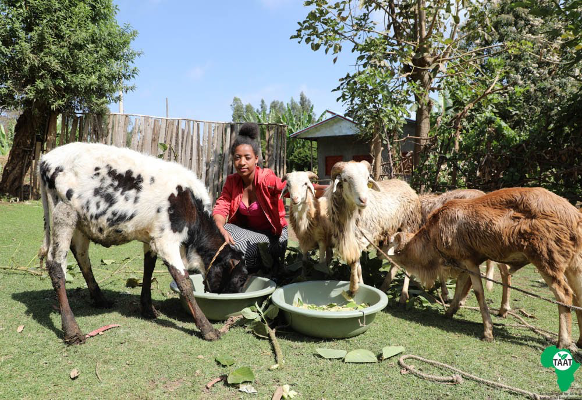Hi. I’m Rachel Zozo, Monitoring and Evaluation Specialist at the International Institute of Tropical Agriculture (IITA), based in Nairobi, Kenya. I have just begun program evaluation and I am happy to share insightful results of an Outcome Case Study of a Sheep Fattening Project in Bonga and Doyogena field sites, Ethiopia. The gap identified and addressed by the Technologies of African Agriculture Transformation (TAAT) Livestock Compact about youth involvement in sheep fattening was an innovative and timely niche identified as the main driver of technology dissemination. The Compact implemented a package comprising a start-up capital of one 6-12 months old ram, one salt-lick block, and a set of feeding and watering containers for a total of 537 rams distributed to 485 young agripreneurs to fatten for 3 to 5 cycles[1]. Additionally, it was required that every beneficiary avail a ram to qualify for the program intervention. Farmers were trained on record keeping (feeding, watering, weighing, deworming, sales and savings) while technicall backstopped. The improved sheep fattening practices have boosted farmers’s interest to tap into the holiday market oriented system targeting peak sale, despite market forces that drive pricing mechanisms impeding income generated from animal sales during the peak period.
Results of the case study show that youths and women have consistently maintained sheep fattening cycles within a short period of 3 months before sales targeting festive seasons. The improved sheep fattening practice increased income and shifted consumption patterns. In September 2018, the purchase price of a young ram was ~2,600ETB (USD80.7) which cost ~6,000ETB (USD186) in March 2020.

Ms. Abaynesh with her livestock asset, photo credit to TAAT Communication Unit
Hot Tip: Consistent sheep fattening cycle as a means for smallholder farmers to climb the livestock ladder and ascend the assets ladder.
Lessons Learned: Emergency private sector in the sheep fattening sector
In Ethiopia, the private sector in sheep fattening is starting to gain interest by seeing more young farmers and women benefiting from the market, it is premature to talk about private sector indulged in entrepreneurship.
Lessons Learned: Mentorship to foster successful agripreneurship skills in youth groups
One of the main attractions of the sheep fattening practice is that it does not require ownership of large piece of land which youth do not own, neither is it labor intensive.
Lessons Learned: maintaining the interest of youth in sheep fattening
To safeguard the interest of youth in sheep fattening, the number of animals made available at the start is a vital parameter that should be carefully maintained.
Rad Resource: Dolberg, F. (2001). A livestock development approach that contributes to poverty alleviation and widespread improvement of nutrition among the poor.
Maass, B., Chiuri, W., Zozo, R., Musale, D., Metre, T. and Birachi, E. (2010). Agro-Ecological Intensification of Agricultural Systems in the African Highlands.
Many thanks to the key partners who participated in the study including the International Livestock Research Institution (ILRI), the International Center for Agricultural Research in the Dry Areas (ICARDA, the National partners in Addis Ababa and Amhara regions, local farming communities and co-operatives. Special thanks to the African Development Bank for funding this work.
[1] A cycle is a period when a sheep is purchased, fattened under good management practices to gain weight (estimated at 66.5g per day) and usually sold within a 3-6 months period.
Do you have questions, concerns, kudos, or content to extend this aea365 contribution? Please add them in the comments section for this post on the aea365 webpage so that we may enrich our community of practice. Would you like to submit an aea365 Tip? Please send a note of interest to aea365@eval.org. aea365 is sponsored by the American Evaluation Association and provides a Tip-a-Day by and for evaluators.

The project leader (and the corresponding organization) from whom all the data in this article originates was not acknowledged. Zozo simply got data during presentations and field visits and totally ignored those who worked hard to gather the data.
Thanks for sharing